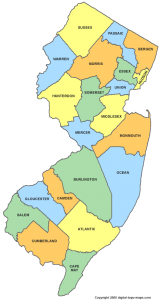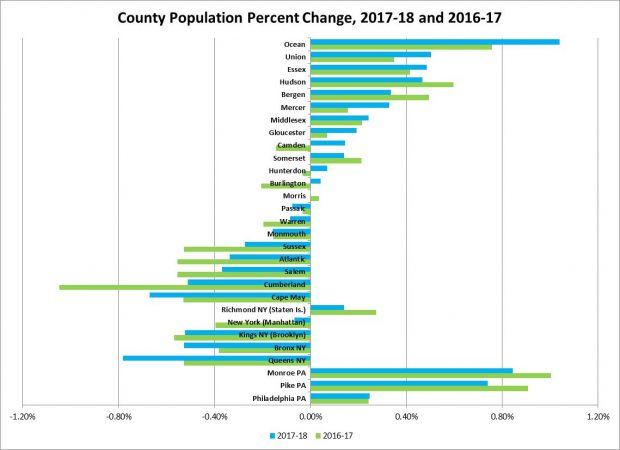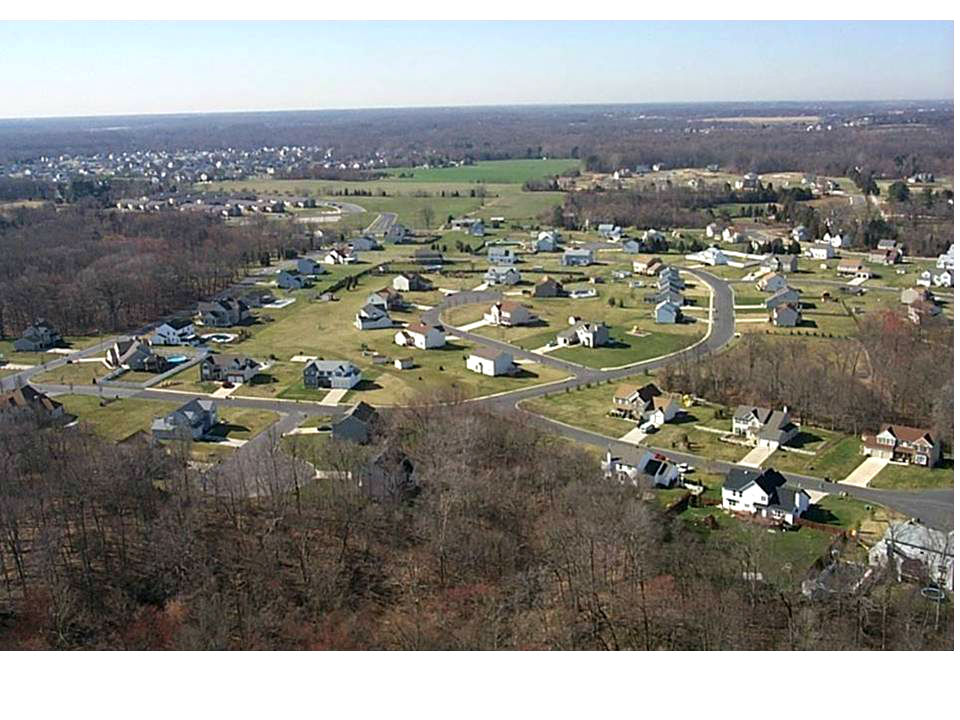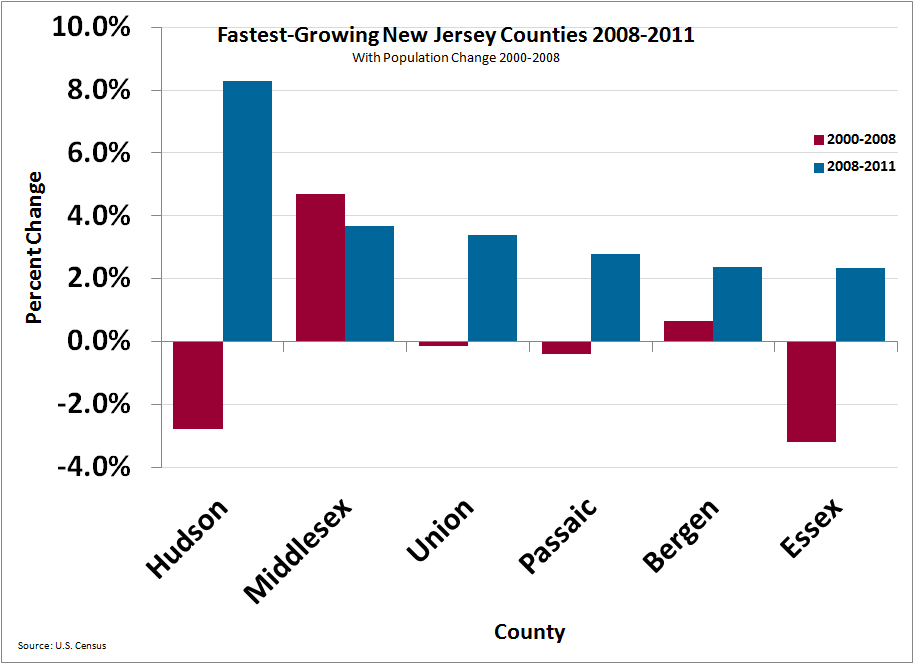New Jersey Future Blog
New County Population Estimates: More of the Same Changes
April 24th, 2019 by Tim Evans
-
New Jersey’s population growth continues to be most pronounced in the North Jersey urban core of Hudson, Essex, Union, and Bergen counties; this is a stark contrast with the 1990s and early 2000s, when most growth was in suburban and exurban counties
- Growth in New York City has ground to a halt, however; four of the five boroughs (all except Staten Island) have lost population in both of the last two years
- Philadelphia – which has much lower housing costs than New York City – continues to grow at a rate comparable to the urbanized counties of North Jersey
- Growth has tentatively returned to the exurban frontier of northeastern Pennsylvania, though not to northwestern New Jersey
- Far southern New Jersey continues to languish, a victim of both a weak Atlantic City economy and a shortage of downtowns that appeal to Millennials
The Census Bureau last week released county population estimates for 2018, along with revised annual estimates for earlier years since the 2010 census. The picture for New Jersey between 2017 and 2018 looks a lot like it has all decade, with the fastest growth happening in the North Jersey urban core and with the northwestern exurbs and far southern New Jersey continuing to languish.
Thirteen of New Jersey’s 21 counties gained population from 2017 to 2018 (in order by growth rate): Ocean, Union, Essex, Hudson, Bergen, Mercer, Middlesex, Gloucester, Camden, Somerset, Hunterdon, Burlington, and Morris. The other eight lost population; listed in order of largest loss rate to smallest, they are: Cape May, Cumberland, Salem, Atlantic, Sussex, Monmouth, Warren, and Passaic. This is a slight improvement from the previous year, when 11 counties lost population from 2016 to 2017; Camden, Burlington, and Hunterdon counties are the three that switched from losing residents between 2016 and 2017 to posting small gains from 2017 to 2018. (See chart below.)
All of this year’s population losers except for Passaic County still have fewer people in 2018 than they did in 2010, as do Burlington, Hunterdon, and Camden counties. Thus almost half of New Jersey’s counties – 10 out of 21 – have negative growth rates for the 2010s so far. Another four – Gloucester, Mercer, Morris, and Passaic – have grown by less than a single percentage point since 2010. For suburban Gloucester and Morris in particular, this represents a substantial dropoff from their growth rates in the 1990s and 2000s.
The consistent bright spot has been New Jersey’s older, more urbanized counties, which, along with Ocean County (which ranked number 1 both this year and last), have led the growth pack. This year, the top seven counties in terms of growth rate – Ocean, Union, Essex, Hudson, Bergen, Mercer, and Middlesex – are also the top seven (though in slightly different order) in terms of the absolute number of residents gained. All of them gained at least 2,000 residents between 2017 and 2018. All of these except Ocean are among the eight most densely populated counties in the state (with Camden and Passaic being the other two densest counties that are not also among the fastest-growing).
Of these seven biggest-gaining counties, only Ocean and Middlesex ranked among the top 10 fastest-growing counties in the 1990s, and only these same two counties ranked in the top 10 from 2000 to 2008, prior to the Great Recession. The other five had previously been growing very slowly, if at all, before growth began returning to built-out places in the late 2000s.
New growth in counties containing a lot of older, walkable centers is consistent with the Millennial generation’s preference for live-work-shop-play environments as they have aged into young adulthood and have moved out on their own. (Well, most of them.)
But while the return to older centers still appears to be an ongoing phenomenon in New Jersey, on the other side of the Hudson River it has hit a wall. After growing between 2010 and 2016 – sometimes at rates outpacing most of New Jersey’s counties – four of the five boroughs of New York City (all except Staten Island) have now lost population for two years in a row, resulting in a net loss of population citywide. Their growth rates for the full 2010-2018 period still exceed those for most New Jersey counties and for Staten Island, but the fact that they have suddenly stopped growing may hint at a looming affordability problem, with new housing supply unable to keep up with demand, driving prices up and discouraging new in-migrants to the city (and encouraging existing residents to leave in search of cheaper options).
In contrast, the same problem is not affecting Philadelphia County (which is coextensive with the city). Its year-over-year growth for 2018 is on a par with North Jersey’s urban counties, as it has been throughout the decade. As with Hudson, Essex, and Union counties in New Jersey, the new round of growth that began in Philadelphia in the mid-00s is a dramatic reversal of several decades of stagnation or outright population loss. Philadelphia may be able to continue capitalizing on the trend a bit longer than New York City has, since it is still much cheaper than New York and may still have some breathing room before housing costs begin to deter new arrivals.
Like Hunterdon County in New Jersey (though not Sussex and Warren), the exurban frontier in northeastern Pennsylvania has also experienced something of a recovery. Monroe and Pike counties in Pennsylvania (which were the outer limits of North Jersey’s exurban fringe in the 1990s and early 2000s), after losing population each year since 2011, reversed their losses and began growing again between 2016 and 2017, and both posted gains again this year. In fact, from 2016 to 2018, Monroe County grew faster than all 21 of New Jersey’s counties in percentage terms, and Pike County grew faster than all but Ocean. In absolute terms, though, their year-to-year increases are very modest compared to what they were experiencing in the two prior decades. It is not clear yet whether these more recent gains might be portending the resumption of the massive outflow from New Jersey and New York that took place in the 1990s and 2000s, or if they simply reflect a natural increase of the existing population, now that Millennial flight from exurban areas may finally be tapering off.
Far southern New Jersey – Atlantic, Cape May, Cumberland, and Salem counties – is experiencing sustained losses; all four counties have lost at least 3% of their population since 2010. The only county anywhere else in New Jersey that has experienced anything similar is Sussex, where population is down by 5.4% since 2010. The whole South Jersey region is likely suffering from a weak economy in Atlantic City, along with a trend at the Shore toward more second homes and fewer year-round residents, and – as in New Jersey’s northwestern corner – a relative lack of urban centers and walkable suburban downtowns that are favored by Millennials.



















Thanks for these reports. I would love to see legislators pass something like California’s SB 10 to allow denser development of areas around train stations, especially in the southern part of the state. Access to Philadelphia has surely helped the walkable older towns in Camden County (and hopefully some in Burlington County) stay above water. We need more of the kinds of downtown mixed-use buildings we’re seeing in places like Collingswood and Westmont!